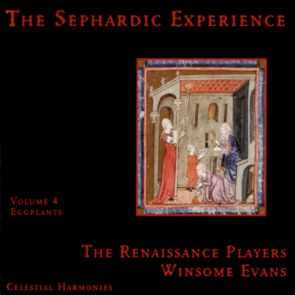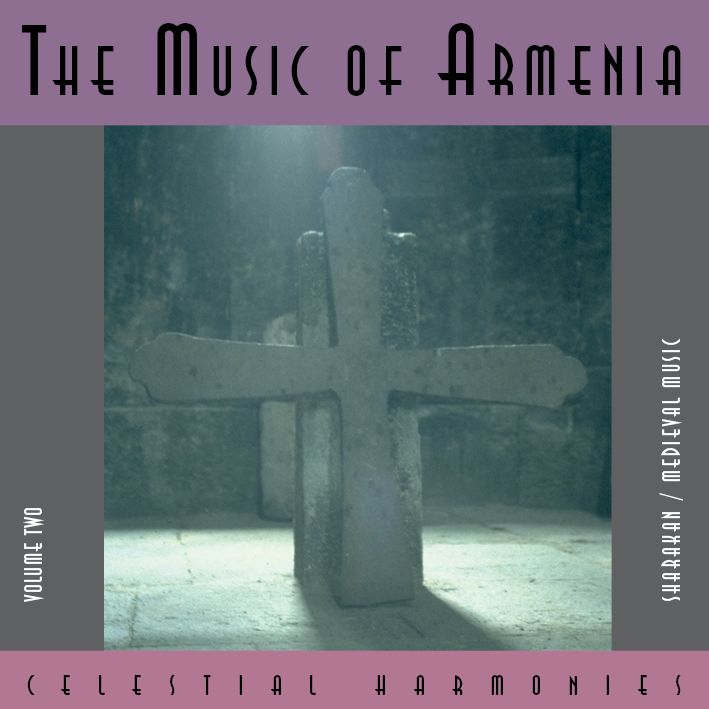
September/October 2000

 13168 THE SEPHARDIC EXPERIENCE,
VOLUME 3: GAZELLE AND FLEA - THE RENAISSANCE PLAYERS,
WINSOME EVANS - DIRECTOR
13168 THE SEPHARDIC EXPERIENCE,
VOLUME 3: GAZELLE AND FLEA - THE RENAISSANCE PLAYERS,
WINSOME EVANS - DIRECTOR

 13169 THE
SEPHARDIC EXPERIENCE, VOLUME 4: EGGPLANTS - THE
RENAISSANCE PLAYERS, WINSOME EVANS - DIRECTOR
13169 THE
SEPHARDIC EXPERIENCE, VOLUME 4: EGGPLANTS - THE
RENAISSANCE PLAYERS, WINSOME EVANS - DIRECTOR
The Renaissance Players continue their exploration of the music of
the Sephardic Jews. This unusual musical repertoire, originating in
medieval Spain, has survived for centuries by way of oral/aural transmission
in the Sephardic communities in Europe, the Ottoman Empire, and North
Africa—but the traditions are rapidly disappearing now. This music
is no longer an integral part of the everyday life of the Sephardim.
We owe the Australia–based Winsome Evans and her Renaissance Players
a hearty thanks for their loving and scholarly interest in this music.
The song texts in Volume 3 cover themes of love from literal and figurative
references involving animals, humans, and insects (gazelle and flea).
Volume 4 concentrates on Macedonian dances, instrumental and vocal songs,
spiritual love, and marital hijinks.
The performances are not only historically and musically accurate (as
far as can be determined), but musically exciting and compelling in
themselves. The virtuoso ensemble plays an array of exotic instruments
(zurna, supeljka, diwan saz, baglama, tapan) as well as the more familiar
us, shawm, psaltery, tabor, harp, gitern, and bouzouki. Two soprano
soloists (Melissa Irwin and Mina Kanaridis—Sephardic songs are
traditionally sung only by women) belt out their songs with considerable
personality and enjoyment. They suffer with the sad; they rejoice with
the happy. The music is heavily rhythmic, ear–catchingly tuneful.
It all adds up to quite an enjoyable show. Notes, texts, and translations
are included.
January/February 2000

 13128
AURORA: THE COMPLETE HILDEGARD VON BINGEN, VOLUME TWO - SINFONYE
13128
AURORA: THE COMPLETE HILDEGARD VON BINGEN, VOLUME TWO - SINFONYE
It has taken a while since Vol. 1 of The Complete Hildegard of Bingen
(13127) appeared for Vol. 2 to come forth, but I am relieved that this
promised series is indeed to go forward.
When I reviewed Vol. 1 (S/O 1996) I praised it for its care in avoiding
the temptation to pile undue modernizing and overlay on Hildegard's
monophonic hymns. If anything, Wishart has gone even further to keep
things strict and plain: there are no instruments at all this time,
and only a couple of pieces are done with an organum–like
extra part added, a perfectly plausible possibility for the period and
place. Otherwise, everything is done by solo or unison voices—Wishart
herself and two adult female Sinfonye colleagues, or members of the
girls' choir. The extension to a relatively childish sound suggests
the image of very young novices joining or juxtaposed with mature nuns
in Hildegard's convent. But, above all, the liberation of Hildegard's
free and ecstatic melodies from the accretions so foolishly added in
so many present–day faddish treatments allows these melodies to
soar on their own terms. These singers put their hearts into it with
wonderful clarity and feeling.
This is the real Hildegard, without hype and without hokum, and this
series offers, I think, the truest of any of the recorded ventures so
far, allowing us to hear her spiritual effusions as she meant them.
After the battering she has taken on discs, I think she would be moved
and grateful to hear these performances. Folks in Tucson: don't keep
us waiting so long for more.
March 1999

 13167 THE SEPHARDIC EXPERIENCE,
VOLUME 2: APPLES AND HONEY - THE RENAISSANCE
PLAYERS, WINSOME EVANS - DIRECTOR
13167 THE SEPHARDIC EXPERIENCE,
VOLUME 2: APPLES AND HONEY - THE RENAISSANCE
PLAYERS, WINSOME EVANS - DIRECTOR
This is the second in a series of CD releases by these performers
based in Sydney, Australia. I was greatly impressed with the first
one (N/D 1998, p. 283).
The series is devoted to the traditions of the Spanish Jews in their
dispersal all around the Mediterranean basin and the Balkans. As with
the first program, called Thorns of Fire, this new one, called Apples
and Honey, is organized around the theme of these two words and the
imagery and symbolism connected with them. The 14 selections range
from direct to allusive, from simple narratives to profoundly mystical
probings.
Most of the material here is of folk derivation, from traditions
out of present–day Greece, Turkey, Persia, Macedonia, Bulgaria,
and generally Balkan or "Middle Eastern". Two selections are read,
and all the music is director Winsome Evans's arrangements of folkloric
survivals, with a sensitivity to their continuing vitality. The performers
are also tuned to ethnic styles and regional performance practices,
but with a bracing musicality that leaves antiquarianism far behind.
There are times when the singers and players seem caught up in their
material with ecstatic fervor, making for some captivating, even hypnotizing
listening. As last time, I am particularly struck by the beautiful
singing of Mina Kanaridis, one of the two sopranos in the group.
As before, the booklet bulges with extensive notes. If this series
continues at this level, it will outstrip the Voice of the Turtle
recordings for Titanic as a commanding survey of the Sephardic literature.
October 1998

 13166 THE
SEPHARDIC EXPERIENCE, VOLUME 1: THORNS OF FIRE - THE
RENAISSANCE PLAYERS, WINSOME EVANS - DIRECTOR
13166 THE
SEPHARDIC EXPERIENCE, VOLUME 1: THORNS OF FIRE - THE
RENAISSANCE PLAYERS, WINSOME EVANS - DIRECTOR
This recording deals with the broad folkloric survivals of the Sephardim
as dispersed around the Mediterranean and the Balkans. It follows
the model set by The Voice of the Turtle (Titanic) for it is announced
as the first in an "extended series of compact discs". Rather than
making each disc focus on a given regional Sephardic tradition, however,
this new series seems to project more of a thematic format, cutting
across the regional blocs. The first volume, for instance, takes its
subtitle from the imagery of the rose that recurs in a good many of
the songs gathered here.
There are 13 selections: eight are songs rendered vocally; three
more song melodies are treated instrumentally, while one is " a newly–composed
dance melody in Macedonian style"; finally, there is a reading (in
English) from the Song of Songs. Many of the songs are bits of romantic
nostalgia, though there are some social pieces, including a fine wedding
song. The burden of the singing is carried by two sopranos with light,
bright voices, Melissa Irwin and Mina Kanaridis. The latter is a particularly
fine singer,. Evans and his six instrumentalists have clearly steeped
themselves in both the appropriate folkloric traditions and the styles
of Arab–Andalusian music–making, so that whether they are
elaborating existing tunes or even making up some of their own material,
they sound so zestful and idiomatic that they are totally convincing.
The album booklet is unusually thick, containing not only full texts
with translations but extensive comments on each piece, preceded by
an elaborate background essay—and this is only the beginning
of what will be continued in the following releases. It may seem odd
that a commanding and highly authoritative survey of the Sephardic
tradition should come from Sydney, Australia, the home of this 30-year
old emsemble, but I have no hesitation in recommending this first
release.
November/December 1997

 13139 HEINRICH
SCHÜTZ DER SCHWANENGESANG (THE SWAN-SONG) - THE
SONG COMPANY, ROLAND PEELMAN - DIRECTOR
13139 HEINRICH
SCHÜTZ DER SCHWANENGESANG (THE SWAN-SONG) - THE
SONG COMPANY, ROLAND PEELMAN - DIRECTOR
Schütz's Schwanengesang (swan songs) were his last works,
11 double choir motet–settings of verses from Psalm 119, part
of Psalm 100, and a Magnificat in German. He wrote most of these at
the remarkable age of 85 or so as a kind of musical reflection of
the verse he had selected for his funeral sermon: Psalm 119:54. Some
have read these pieces as a kind of artistic reproach to the newer
and more extroverted Italian style that had become prevalent even
in Dresden, where he had been court musician from 1615 up to the end
of his life in 1672. Others take them simply as a kind of summary
of his art.
These are wonderful pieces, rich and moving and written with amazing
lucidity and economy. There isn't an extra note in any of them.
Peelman and his Australian group perform them with one voice to a
part and a simple organ accompaniment. His singers are a good lot,
though the tenor who gives the intonations sounds like a light–voiced
Jon Vickers—an odd association here. The performances are very
straightforward and plain. Schütz, who spent a large part of
his career in Dresden begging for resources from a court bled of men
and wealth by the 30 Years War, would have understood and might have
appreciated the simplicity.
September/October 1996

 13116 THE
MUSIC OF ARMENIA, VOLUME TWO: SHARAKAN - DANIEL
ERAZHISHT, DIRECTOR
13116 THE
MUSIC OF ARMENIA, VOLUME TWO: SHARAKAN - DANIEL
ERAZHISHT, DIRECTOR
This is the second volume of a series that was planned, recorded
and produced by David Parsons. The first disc is devoted to choral
liturgical music of the Armenian Church, and the later ones sample
areas of Armenian traditional, folk, and topical music down to the
present.
The extraordinary tenacity of that culture's survival in the face
of conquest, dispersion, persecution, and massacre might be matched
only by the Jewish tradition. And, as with the latter, it seems to
be flourishing once again with the achievement of an independent statehood
and cultural revival. That revival is demonstrated by this series,
where musicians and ensembles of Yerevan, capital of today's Armenia,
are documented.
This volume bears the title sharakan, which derives from the
word for "sequence" and is translated poetically as "jewel
necklace", though musically it refers to the order of sacred
rituals in the Church. To its para–liturgical literature are
added the other categories of song—the folk–derived tagh
and the semi–declamatory gandz—both supplemental
to, if outside of, the official liturgical offices. The composition
of these melodies extends back to the origins of Armenian Christianity
in the Fourth Century. They are the work of generations of poet–musicians
who have been compared to the troubadours of medieval Western Europe,
but they might best be compared to such products as the Cantigas of
Alfonso El Sabio.
A key figure in modern Armenian musical tradition was Komitas Vardapet,
or Vardabedian (1869–1935), who, among other things, was an inspiration
to our Alan Hovhaness. His transcriptions and arrangements are the
foundation for these performances. It must be stressed that these
are "modernizations" without any antiquarian character.
The adapted melodies, 22 of them, are sung by a solo vocalist accompanied
by various combinations of flute, piano, and string quartet. The results
are tasteful and often extraordinarily lovely, if not the least bit
"medieval". The three female singers have lovely voices
and perform with deep commitment.
Thorough annotations are supplied, but texts and translations are
omitted in favor of short descriptive notes on each piece. If your
only contact with Armenian music has been through the filter of Hovhaness,
you might try this more direct approach.
March/April 1996

 13115 THE
MUSIC OF ARMENIA, VOLUME ONE: SACRED CHORAL MUSIC - THE
HAISSMAVOURK CHOIR/MIHRAN GHAZELIAN, DIRECTOR
13115 THE
MUSIC OF ARMENIA, VOLUME ONE: SACRED CHORAL MUSIC - THE
HAISSMAVOURK CHOIR/MIHRAN GHAZELIAN, DIRECTOR
This one looked like the runt of the litter. I mean, Armenia
for crying out loud! Serves me right for pre–judging. It turns
out this is a gorgeously sung program of music that wears its exotic
spirituality with great sincerity and unpretentious beauty. Armenia
was the first country to adopt Christianity (in 301) and also the
first church to be excommunicated en masse. (It was over the
issue of monophysitism—the heretical challenge to the doctrine
that Jesus was both human and divine.)
Armenia has a long, fascinating religious history, recounted here
in the juiciest set of liner notes I've ever read. Like the country
itself, Armenia's music shows many influences. Chanted in Grabar,
not Latin, it sounds like Gregorian sometimes, but not quite. Some
works sound quite European, but when the fellows enter on their drone
harmonies and the modal chants take on Islamic, Jewish, or oriental
flavors, it doesn't take long to conclude that, Toto, we're not in
Kansas any more. You might not want to hunker down for the full 75
minutes each and every time you play this, but music that speaks so
eloquently of mankind's quest to know God through artistic creativity
deserved to be heard. Everything about this from the singing to the
notes to the producer's comments about Armenia and its people speaks
of great care and love. Yes, Armenia! If you're up for something
beautiful and exotic, you've found it here.
|



